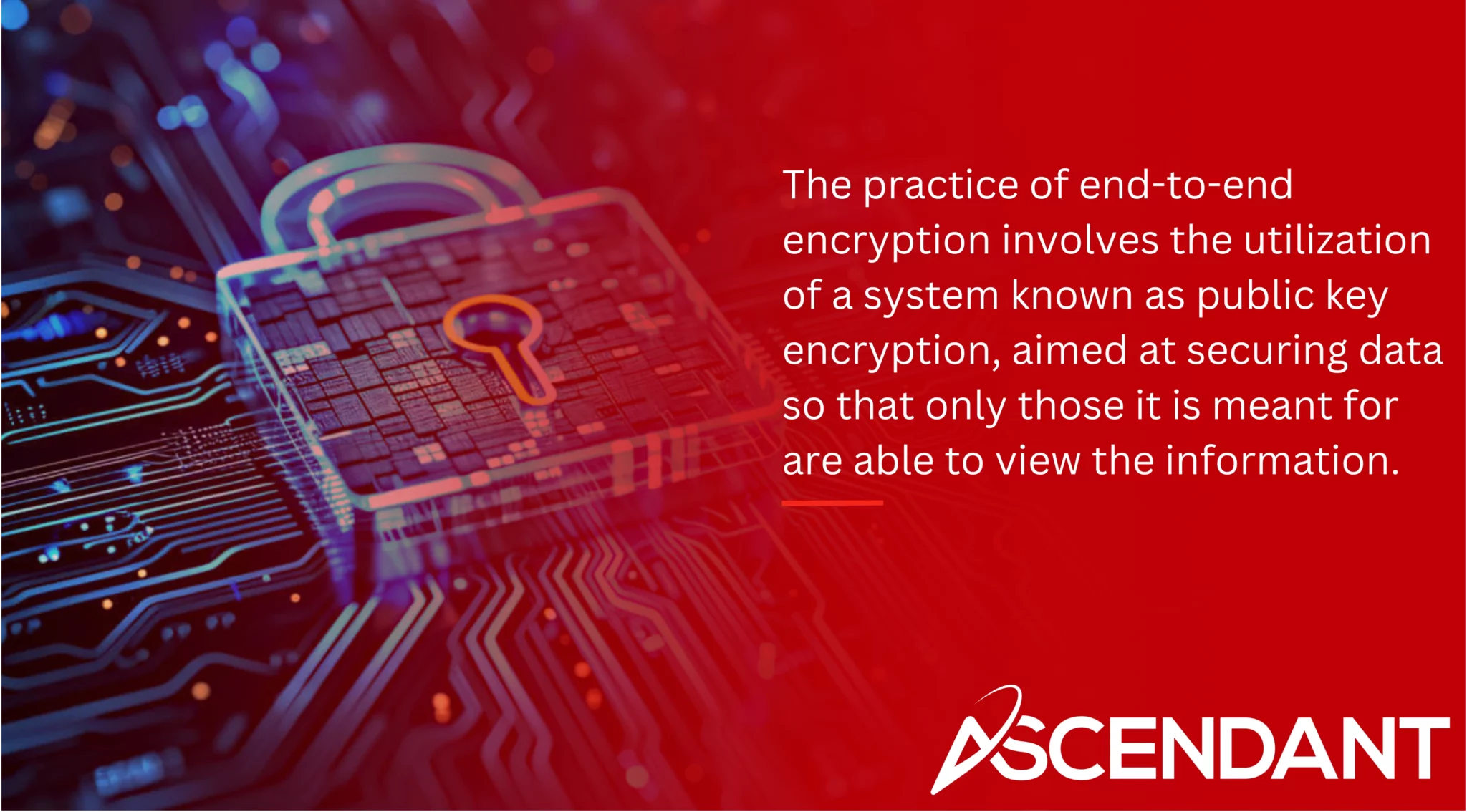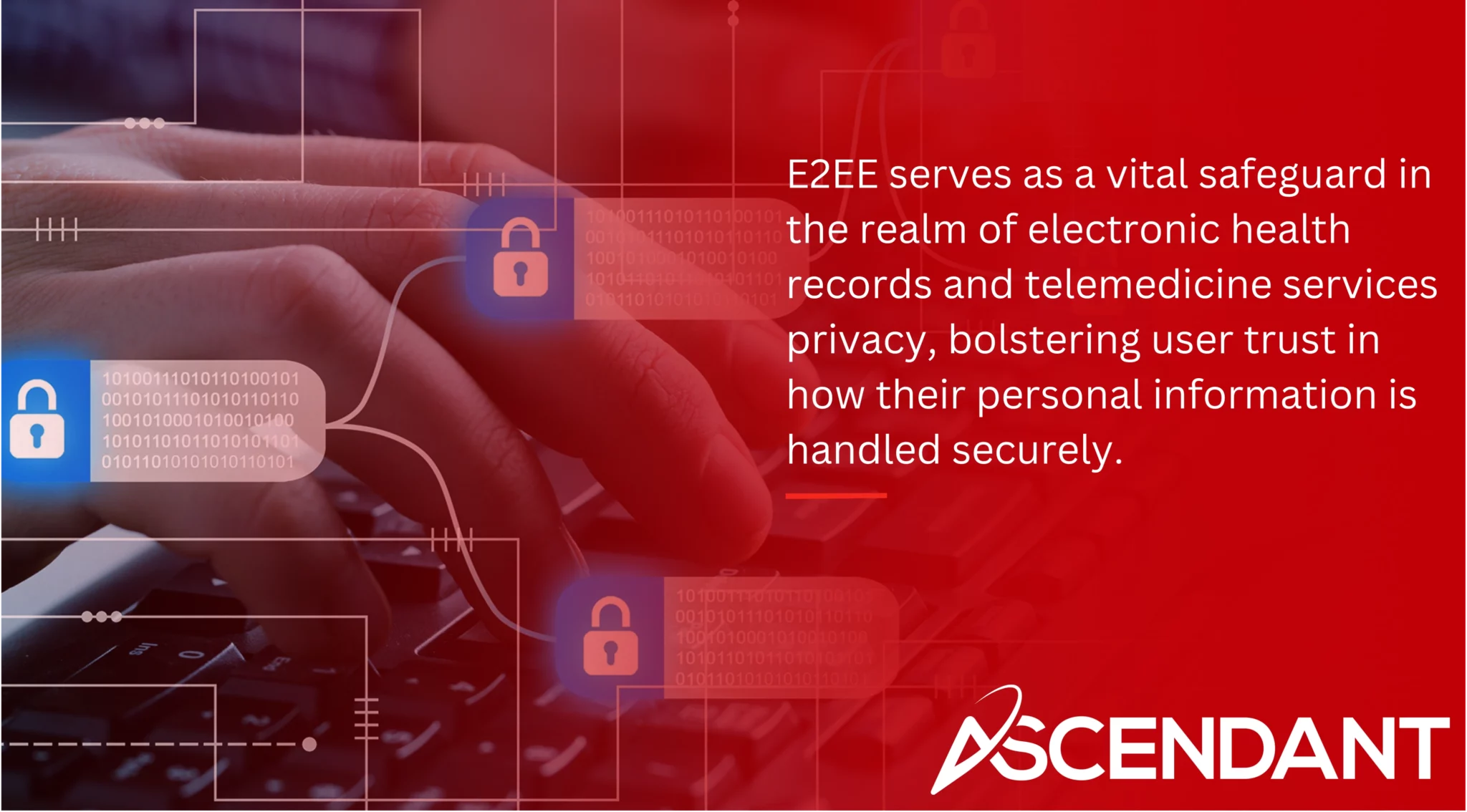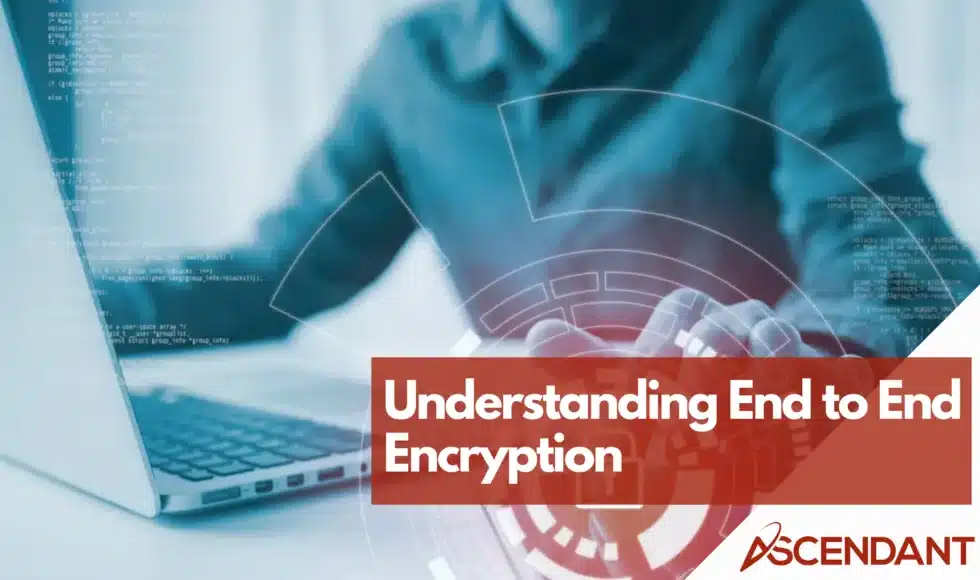End to end encryption (E2EE) ensures that only the sender and recipient can access messages, protecting data from unauthorized access. This article explains how E2EE works, its benefits, and its key applications.
Key Takeaways
- End-to-end encryption (E2EE) secures communications by ensuring that only the sender and recipient can access the content, utilizing a public-private key system to protect data during transmission.
- E2EE provides key advantages over other encryption methods, including enhanced security against unauthorized access and compliance with data protection regulations, but it is not immune to potential vulnerabilities and implementation challenges.
- Real-world applications of E2EE span various sectors, including finance, healthcare, and messaging platforms, underscoring its significance in protecting sensitive information and maintaining user privacy.
Understanding End-to-End Encryption (E2EE)
End-to-end encryption is a secure communication method that obstructs third-party entities from accessing data during transmission, guaranteeing the privacy of messages by allowing only the communicating parties to view them. Its core aim is to establish a channel where exclusively those participating in the conversation have access to message contents. Consequently, even if an unauthorized party intercepts the data en route, without possession of necessary keys they cannot decipher it. The architecture of E2EE upholds strict controls over encryption keys usage and ensures that only sender and recipient are equipped with these specific keys needed for access, safeguarding their privacy rights.
A fundamental element of end-to-end encryption lies in its deployment of cryptographic key management, which permits only engaged communicators direct entry to required decryption tools, a practice reinforcing both endpoint security against intrusions and general protection over sensitive information being shared or stored.
Understanding how end-to-end encryptions operate—including awareness around utilization—and recognizing public versus private key roles remain essential components for grasping this robust security measure’s essence within user communications environments.
How E2EE Works

The practice of end-to-end encryption involves the utilization of a system known as public key encryption, aimed at securing data so that only those it is meant for are able to view the information. When an individual seeks to send a message in a secure fashion, they take advantage of the intended recipient’s public key for encrypting the data prior to dispatch. The resulting encrypted message necessitates decryption by means of the intended recipient’s private key alone. This specific employment of both keys secures communication against unauthorized access during transmission. Without access to this special pair, intercepted messages remain unreadable.
This method operates by having the sender employ the publicly accessible but uncrackable public key associated with their correspondent for encoding their message. Subsequently, decipherment can be achieved exclusively through use of its unique counterpart: an individually held private key.
By adopting such measures and using these types of keys when sending and receiving data, one ensures comprehensive security throughout transit from start point to endpoint—thereby guaranteeing content accessibility solely for those recipients as designated originally.
Public Key vs. Private Key
The public key encryption system plays an integral role in the security of end-to-end encrypted communication. With this approach, messages are secured using a public key for encryption, ensuring that only individuals with the corresponding private decryption key can access these encrypted messages. This dual-key setup maintains message confidentiality since intercepting the public key does not compromise security. Decrypted contents remain exclusive to those possessing the private key.
End-to-end encryption (E2EE) distinguishes itself from symmetric key encryption by employing two separate keys: one is used to encrypt messages (the public key), and another distinct one serves as a decryption tool (the private key). The division of keys boosts overall safety because it keeps the crucially confidential private key undisclosed and solely in possession of its authorized recipient. Consequently, no other party aside from this intended receiver has any means to decrypt or understand what’s been encoded within a secure message.
Comparing E2EE with Other Encryption Types
Grasping the nuances between different encryption types is essential for securing digital communication. End-to-end (E2E) encryption ensures that only the sender and receiver have the capability to decrypt and view messages. This distinguishes E2EE from other forms of encryption where intermediate servers or parties might be able to access message contents as they’re being transmitted. Even with its heightened security features, end-to-end encryption may still be vulnerable to risks such as breaches at endpoint levels or keyloggers capturing information directly from a user’s device.
One shortfall of end-to-end encryption is its failure to encrypt metadata, which could reveal identities of those communicating and when they communicated. Adoption of E2EE can pose obstacles for legal investigations by restricting entry to vital data.
In essence, the fundamental benefit offered by E2E security rests in its provision for safeguarding messages so that their content remains unreadable during transmission. This guarantees exclusive access only for both originator and intended recipient upon receipt. When juxtaposed against symmetric key approaches or transit-phase encryptions, significant distinctions become apparent in how each handles data protection through these various techniques.
Symmetric Key Encryption
Symmetric key encryption uses a single key to encrypt and decrypt messages, requiring both the sender and receiver to share the same key. This method is faster than E2EE because it relies on a single key for both processes. However, this approach introduces significant security risks. If the shared key is intercepted, both parties’ communications could be compromised. Unlike E2EE, which uses separate public and private keys, symmetric key encryption’s reliance on a single key makes it more vulnerable to unauthorized access.
In comparison, while E2EE might be slower due to the use of two keys, it provides a higher level of security by ensuring that only the intended recipients can decrypt the messages. This makes E2EE a more secure choice for protecting sensitive data, despite performance trade-offs.
Encryption in Transit
The process of encryption in transit serves to secure data while it travels across various networks, ensuring its protection as it moves from one device to another. This technique guarantees that the messages are encrypted throughout their transmission, thwarting attempts by unauthorized parties to access the information en route. Nevertheless, upon arrival at an intermediate server, this data may be decrypted for examination purposes—signifying a potential vulnerability when such data is stored on these servers.
End-to-end encryption elevates security measures by assuring that only individuals involved in sending and receiving can gain entry to message contents. All others are barred from accessing or inspecting the communication. Such robust protection via E2EE technology is highly effective not just during transit but also secures messages continuously until they reach their final destination.
Given these considerations about conventional transit encryption’s limitations, using end-to-end techniques becomes crucial for sensitive exchanges demanding stringent confidentiality since they cannot be accessed or decoded except by the designated communicating parties.
Real-World Applications of E2EE
Before, end-to-end encryption is not just a theoretical concept; it has practical applications across various industries. In the financial services sector, E2EE is essential for protecting transactions and sensitive customer information from fraud and unauthorized access. In healthcare, E2EE keeps patient data confidential and aligns with regulatory requirements. Even in the educational sector, E2EE facilitates secure communications between teachers and parents, safeguarding personal information.
End-to-end encryption (E2EE) has practical applications across various industries, including:
- Financial Services: Essential for protecting transactions and sensitive customer information from fraud and unauthorized access.
- Healthcare: Keeps patient data confidential and aligns with regulatory requirements.
- Education: Facilitates secure communications between teachers and parents, safeguarding personal information.
One major advantage of E2EE is its ability to protect data from being exploited even if a server is hacked. This makes it a crucial tool for enhancing confidentiality and data security in many industries. Let’s delve into specific applications of E2EE in messaging apps, financial services, and healthcare.
Messaging Apps
Leading messaging applications, such as Apple’s iMessage and Signal, employ end-to-end encryption (E2EE) to safeguard the communications of their users. Meta has followed suit by integrating E2EE as a default feature for private conversations and voice calls on Messenger. Notably, Signal is highly acclaimed for its strong encryption standards that ensure secure text messages and phone calls.
The significance of incorporating E2EE within messaging platforms is pivotal in enhancing the security of interactions and shielding confidential data from unauthorized entities. By guaranteeing that only the intended recipient of a message can decrypt it, these applications provide an elevated measure of privacy and protection for their users.
Financial Services
In the realm of financial services, end-to-end encryption is employed to fortify online banking transactions and shield them from fraud and illicit access. End-to-end encryption plays an essential role in protecting payment card data as it moves from merchants to payment processors, guaranteeing that sensitive information is securely maintained during transit.
Financial institutions leverage end-to-end encryption to create a secure space for their clients, thereby bolstering trust and assurance in the services provided. This renders end-to-end encryption an invaluable asset for upholding data security and safeguarding confidential financial data.
Healthcare
In the realm of healthcare, employing end-to-end encryption is crucial for adhering to numerous statutory requirements regarding data protection, such as those mandated by the General Data Protection Regulation (GDPR). End-to-end encryption serves as a vital tool in preserving the confidentiality of patient details, thereby fostering trust and protecting sensitive health information. This safeguard is especially critical when dealing with electronic health records and telemedicine services where maintaining both the integrity and privacy of patient data is essential.
Increasingly, regulatory bodies are advocating for end-to-end encryption’s role in securing personal data. Thus it becomes an indispensable element within healthcare’s data security strategies. With E2EE implementation, healthcare organizations can guarantee that access to patients’ information remains restricted to only those who are authorized—significantly bolstering the measures taken towards ensuring both security and compliance regarding private medical information.
Benefits of End-to-End Encryption
End-to-end encryption is a critical component for ensuring secure communication, offering significant advantages by guaranteeing that only the individuals for whom data is intended can access message contents. This formidable level of security helps to safeguard against unauthorized viewing and ensures confidentiality of sensitive information.

E2EE serves as a vital safeguard in the realm of electronic health records and telemedicine services privacy, bolstering user trust in how their personal information is handled securely. The adoption of end-to-end encryption also assists organizations in adhering to regulatory demands, presenting itself as an indispensable tool for both maintaining data protection and fulfilling privacy regulations.
The subsequent sections will delve deeper into these key aspects under the topics ‘Data Security’ and ‘Privacy Compliance’.
Data Security
Sensitive data is safeguarded through end-to-end encryption (E2EE), which obstructs the ability of internet service providers, app developers, and cyber criminals to view or alter messages. By encrypting data throughout its journey, this method offers a more robust security solution than other encryption strategies. E2EE provides superior defense for user information in the unfortunate event of a data breach by ensuring that even if accessed, encrypted content remains indecipherable to those without proper authorization.
By restricting access to transmitted messages exclusively between users engaged in communication, E2EE significantly bolsters data protection. It plays an essential role in securing confidential information like personal identity details and financial records from interception and misuse by nefarious entities.
Privacy Compliance
Utilizing end-to-end encryption enables firms to adhere to data privacy and security laws like GDPR and HIPAA, which require stringent safeguards for sensitive information.
Implementing E2EE allows organizations to align their data security methods with the requisite legal and ethical obligations, diminishing the chance of regulatory breaches while bolstering comprehensive data protection.
Challenges and Limitations of E2EE
End-to-end encryption is a potent form of data security, yet it’s not impervious to challenges and potential shortcomings. The reality that E2EE cannot provide invulnerable security stems from the possibility of attackers exploiting certain weaknesses, including the absence of authentication for user keys and unverified public keys. Future threats might arise with advancements in quantum computing technology, which could possibly decrypt current encryption methods.
Nevertheless, despite these obstacles, end-to-end encryption stands as an influential defense mechanism for protecting communication streams. It remains crucial to recognize its possible vulnerabilities and acknowledge issues related to deployment so as to utilize this tool effectively.
To gain a deeper understanding of these matters, we will investigate Potential Vulnerabilities along with Implementation Challenges in the forthcoming subsections.
Potential Vulnerabilities
The necessity for ongoing enhancement and attention is highlighted by the discovered flaws in encryption protocols. At present, the key exchange mechanism employed in end-to-end encryption (E2EE) remains impervious to being cracked with existing algorithms and computing capabilities. This might change as technology advances. Should Rich Communication Services (RCS) chats be misplaced, it renders E2EE unfeasible for those specific messages.
Incorporating perfect forward secrecy fortifies security within an E2EE framework by guaranteeing that even if a particular encryption key were to be exposed or compromised, such a breach wouldn’t allow past communications to be decrypted. This approach greatly diminishes the risk associated with any single key compromise while continuing to shield sensitive data from unauthorized access.
Implementation Challenges
Employing end-to-end encryption (E2EE) on multiple platforms can pose difficulties due to the need for uniform management of encryption keys and adherence to specific protocols. It’s critical to keep the encryption keys in a secure location away from encrypted data, ensuring they are not susceptible to unauthorized access. Extending E2EE across a range of devices introduces additional complexity in sustaining consistent application of encryption standards.
Incorporation of E2EE into an existing computer system often encounters obstacles related to user interface design that might undermine security measures. To verify the ongoing reliability and integrity against potential threats, it is essential continuously test the efficacy and security resilience of the encryption system.
Notwithstanding these obstacles, adopting E2EE offers significant advantages by enhancing communication security and safeguarding sensitive data against breaches.
Commercial Products Using E2EE
End-to-end encrypted commercial services provide improved security measures for a variety of communication requirements. Take PreVeil as an example, which is a secure service offering email and file storage that safeguards against password breaches, serious attacks, and unauthorized administrators’ actions. It has gained the trust of more than 1,200 defense contractors who rely on it to meet their compliance and security demands. The service is compatible with numerous devices such as Windows PCs, Macintosh computers, iPhone/iPad units, Android systems, and other mobile platforms.
When utilizing end encryption technologies like this one, the data in messages stays securely encrypted even when stored on intermediate servers. This prevents any third parties or service providers from accessing them—maintaining data privacy throughout its transmission process is critical to protect sensitive communications effectively.
Email Systems
Email service providers such as ProtonMail and Tutanota deliver secure messaging through end-to-end encryption, guaranteeing the protection of emails both in transit and when stored. Virtru offers an additional layer of data security by facilitating email encryption on familiar platforms like Gmail and Outlook. Similarly, PreVeil extends its robust encryption services to work seamlessly with Outlook, Gmail, and Mac Mail for heightened email communication security.
By leveraging these systems, users have the capability to exchange messages that are encrypted from start to finish, significantly bolstering their data privacy and protection against unauthorized access. The seamless integration of end-to-end (E2EE) encryption into mainstream email clients ensures that any sensitive information handled by these services remains confidential throughout its lifecycle.
Communication Platforms
Visual cues are essential for verifying that communication tools employ end-to-end encryption. As an illustration, Google Messages showcases a lock symbol on the send button to denote active E2EE, and frequently you’ll notice similar symbols such as locks adjacent to messages or within the messaging environment itself. Certain services notify users when their communications become encrypted or if there is any alteration in encryption configurations.
These visual signs assist individuals in effortlessly discerning secure communication channels, thereby bolstering data security confidence. When users spot these indicators, they can be reassured that their messages are protected against unwarranted access.
How to Recognize E2EE in Use
It is essential to acknowledge the importance of end-to-end encryption as a measure for securing data across different platforms. Symbols like padlocks or distinct icons within chat apps signal that E2EE has been engaged. Verifying through the internet service provider’s official communications or published documents ensures that their services indeed employ this level of security.
Such signs provide reassurance to users about the security of their exchanges, enhancing trust in how their data is safeguarded. We will delve into these visual cues and statements made by internet service providers more thoroughly.
Visual Indicators
Visual indicators, such as distinctive icons or alerts within an app, frequently signal the use of end-to-end encryption. For example, in Google Messages, a lock icon appears on the send button and adjacent to the timestamp of a message when end-to-end encryption is engaged. A distinct verification code can be employed to affirm that E2EE is operational.
Such visual signs offer users a straightforward method to authenticate their communication’s security level. This reassures them that their messages are protected against unsanctioned access thanks to encryption measures.
Service Provider Statements
Service providers frequently provide detailed documentation on the functionality of their end-to-end encryption. For precise information regarding the implemented encryption protocols, users are encouraged to consult with these official documents from service providers. Official pronouncements clarify if messaging services specifically utilize end-to-end encryption.
By examining such materials, users gain insights into the security level that their data enjoys under their chosen services. It’s crucial for users to look at documented sources and formal communications to confirm the active application and proper operation of E2EE in securing their data.
Enhancing Personal Security with E2EE
Improving individual data security through the use of end-to-end encryption necessitates selecting appropriate applications and adhering to optimal practices. It’s essential to grasp the weak spots within E2EE systems in order to guard personal information with maximum efficiency. Opting for apps that offer robust end-to-end encryption alongside enacting recommended safety strategies can greatly bolster protection of one’s data.
We shall delve into methods for picking out apps equipped with end-to-end encryption and investigate top-tier practices that contribute to sustaining a secure environment in subsequent segments.
Choosing E2EE-enabled Apps
Seek out applications with robust E2EE capabilities, ensuring they use strong encryption standards and refrain from retaining encryption keys on their servers. Opt for services that genuinely implement end-to-end encryption, guaranteeing your data stays encrypted in transit without being decipherable by the service providers themselves. Choose apps that transparently convey their approach to encryption and allow you to maintain exclusive control over your own encryption keys.
In choosing apps featuring end-to-end security, prioritize those deploying reputable encryptions protocols such as AES or the Signal Protocol. These technologies are known for their high level of security and have been established as trusted options for safeguarding sensitive information against unauthorized access.
Best Practices
Upholding robust practices is vital for securing privacy and safeguarding data via end-to-end encryption. It’s imperative to keep applications up to date and employ intricate passwords to boost security levels. Steer clear of simplistic passwords that could be swiftly guessed, which would increase the risk of unwanted access into your encrypted accounts. For an additional layer of protection on services that provide end-to-end encryption, activating two-factor authentication is recommended.
Adhering strictly to these best practices allows users the peace of mind that their data will remain protected against various threats. Ensuring regular software updates coupled with setting strong passwords are straightforward yet effective methods in reinforcing individual security when utilizing E2EE technology.
Summary
Summarizing, the implementation of end-to-end encryption serves as a formidable method for preserving the security of data and facilitating communications that are secure. Through gaining an understanding of how end to end encryption operates, assessing its advantages over other forms of encryption, and observing its use in practical scenarios, individuals can recognize its critical role in protecting sensitive information. Despite facing certain challenges and constraints, the importance it holds for ensuring data security and adherence to privacy regulations cannot be overstated—it remains a crucial feature within contemporary communication methods.
As we traverse through an era dominated by digital interactions, adopting practices centered around E2EE alongside adhering to recommended personal security protocols substantially bolsters our defenses against breaches in data protection. Harness the strength offered by end-to-end encryption strategies—make today the day you reinforce your command over online confidentiality.
 Frequently Asked Questions
Frequently Asked Questions
How do I turn off end-to-end encryption in messages?
To turn off end-to-end encryption in messages, access the settings by clicking the three-lined icon in the top left corner, then select the gear icon in the right corner and navigate to the privacy settings.
What is end-to-end encryption (E2EE)?
End-to-end encryption (E2EE) is a secure communication method that ensures only the intended communicating users can access and read the messages, effectively preventing unauthorized third-party access to the data.
How does end-to-end encryption work?
End-to-end encryption (E2EE) operates through public key encryption, where the sender encrypts messages using the recipient’s public key, and only the recipient can decrypt them with their private key.
This ensures that only the intended recipient can access the content of the communication.
What are the benefits of using end-to-end encryption?
End-to-end encryption (E2EE) ensures robust data security by safeguarding messages from unauthorized access and assists organizations in complying with data privacy regulations.
This creates a more secure communication environment.
What are the challenges associated with end-to-end encryption?
End-to-end encryption is confronted with difficulties including possible security flaws, the intricacies of deploying it, and the emerging threat posed by quantum computing developments.
Such problems have the potential to undermine both the safety and efficiency of communications that rely on end-to-end encrypted protection.

